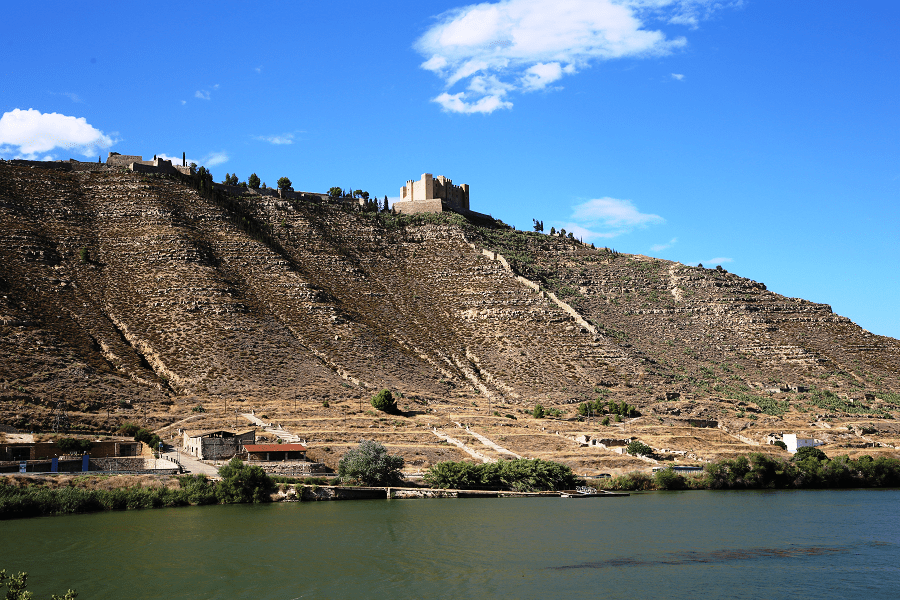Mequinenza Dam is a concrete gravity dam in the province of Zaragoza, Aragon community, Spain. It impounds the Ebro river creating a large reservoir, which is called Mar de Aragón (Aragon sea).
Built in 1966 on the Ebro river, it has an area of 7,540 hectares of water, being the largest reservoir in Aragon. Its volume reaches 1530 hm³, dedicated to the production of electrical energy. It has an average width of 600 m and its depth exceeds 60 m. The 79 m high dam rests on the limestone foothills of the Montenegre and La Huerta mountain ranges, in the municipality of Mequinenza.
The reservoir receives the geotouristic denomination of Mar de Aragón serving in some section of the provincial boundary between Huesca and Zaragoza. Anega part of the municipalities of Mequinenza, Fraga, Caspe, Chiprana, Sástago and Escatrón. The towns of Chiprana and Caspe, located in the Bajo Aragón-Caspe region, are coastal.
Technical characteristics of the basin
Total area of the basin 55,000 km²
Average annual rainfall 561 mm
Average annual contribution 9190 hm²
Average river flow 290 m³ / s
Maximum known annual contribution 17 529 hm³ (year 1959-1960)
Minimum known annual contribution 256 817 529 hm³ (year 1948-1949)
Maximum known avenue 4100 m³ / s (January 1961)
Technical characteristics of the Mequinenza Reservoir
Total volume 1530 hm³
Useful volume 1338 hm³
Maximum height of the reservoir 121 m.s.n.m.
Maximum area 7540 ha
Backwater length 110 km
Average annual evaporation 80 Hm³
Technical Characteristics of the Mequinenza Dam
Gravity type, rectilinear plan with slopes
Maximum height above channel 65 m
Maximum height above foundations 79 m
Maximum height above rake foundations 84.20 m
Length of crest 461 m
Excavation volume 500,000 m²
Concrete volume (including central) 1,100,000 m²
Gated area 22,900 m²
Spillway and Drainage Features
Maximum spillway evacuation capacity 11,000 m³ / s
Spillway threshold height 106.50
Maximum evacuation capacity for lightening drains 1800 m³ / s
Threshold height for lightening drains 87.00
Maximum drainage capacity for bottom drains 160 m³ / s
Floor drain threshold height 60
Ecosystem
The river ecosystem of the reservoir is quite balanced. Faced with very prolific fish such as common carp and alburno, there are some predators such as catfish – the largest inland fish in Europe, endowed with large bales and nocturnal activity – and black bass.
You can also find land predators such as the gray heron, the kingfisher, the martinete and the mallard. Almost all these species are non-native – artificially introduced – which has led to the disappearance of certain autochthonous species such as the great crested grebe. Among the vertebrates linked to the fluvial environment, the Iberian terrapin subsists.
In recent years, the zebra mussel has proliferated in the Mequinenza reservoir. Native to the Caspian Sea and the Black Sea, it has successfully adapted to the new habitat and is a veritable pest.
In agriculture, pipes used for irrigation have been affected, blocked by the enormous proliferation of these mollusks.
Fishing
Fishing is probably the biggest tourist attraction for visitors to the Sea of Aragon. From the beginning it was understood that the Mequinenza reservoir was a powerful source of tourist attraction and the fishing societies.
In 1965, 20,000 largemouth bass fry and 175,000 royal carp fry were released.
It was the beginning of the great current fish wealth; the reservoir is thought to contain more than 50 million fish.
For this reason, it is not surprising that no less than 30 competitions are held a year, highlighting the National Fishing Championship and the National Competition of Cyprinids “Autonomy of Aragón”, within the traditional arts and several international championships for black bass fishing.
GPS location: 41°23′42″N 0°08′56″E













